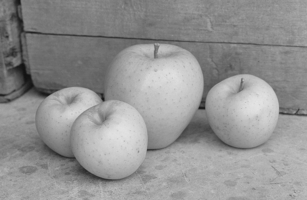 | Back to e-WV
| Back to e-WV
 The West Virginia Encyclopedia
The West Virginia Encyclopedia
 | Back to e-WV
| Back to e-WV
 The West Virginia Encyclopedia
The West Virginia Encyclopedia

West Virginia has produced two great apples, the first of which was the Grimes Golden, discovered about 1805 on the farm of Thomas Grimes at Fowlersville near Wellsburg, supposedly from a seed planted by Johnny Appleseed. Considered by some to be the best frying apple ever, the Grimes Golden was commonly grown in home and commercial orchards until the early 1940s, when the Golden Delicious largely displaced it.
Anderson Mullins discovered the Golden Delicious, thought to be a chance offspring of a Grimes Golden, in 1912 in Clay County. The tree was purchased by Stark Brothers’ Nursery, which built a cage around the tree and protected it for many years while propagating the Golden Delicious worldwide. This aromatic fruit is a fine eating apple and a good keeper, unexcelled as an all-purpose apple. The Golden Delicious is the second most popular apple in the country. Those grown in the West are larger, smoother, and more uniformly colored than the tastier, freckled Golden Delicious grown in West Virginia. Lawmakers named the Golden Delicious the West Virginia state apple in 1995.
Commercially, the growing of both apples and peaches takes place mostly in the Eastern Panhandle, where the Shenandoah Valley provides ideal climate and soil.
The growing of apples over the years has passed from standard-size apple trees growing 25 feet tall, to semi-dwarf apple trees growing 15 feet tall, to dwarf apple trees growing seven to nine feet tall and trained onto wires. The modern commercial apple orchard bears more than a little resemblance to a grape vineyard.
Unlike a bean or a pea, apples do not grow true from seed. Rather, skilled workers graft a bud of a desired variety onto a rootstock of another variety. The graft is chosen for its fruit, while the rootstock may be chosen for its sturdiness or other qualities. Thus, every commercially productive apple tree is a man-made union of two apple trees, producing the fruit of the grafted-on variety. New varieties arise through chance or deliberate breeding and are themselves then propagated by grafting. A few dedicated people labor to keep the gene pool alive and the old apples growing. Carlos Manning is one such person, growing nearly 300 varieties in his nursery in Lester, Raleigh County.
Depressed prices, in part caused by imports of apple juice, make it difficult for all but growers of premium-priced specialty apples to survive. Two such growers excelled into the early 2000s. Morgan Orchard in Monroe County raised some 50 varieties for the commercial market; it closed in 2019. The former Summit Point Raceway Orchards in Jefferson County, once owned by Barbara and William Scott, almost single-handedly created a grocery store market for the Nittany, a crisp, juicy, and flavorful keeping apple whose red skin with yellow blush was once considered unattractive. Both Morgan Orchard and Summit Point helped revive the York, a flattened, bi-colored crisp keeper that had just about vanished from commercial orchards.
Another major retailer and wholesaler, Orr’s Farm Market in Martinsburg, has been in business since 1954. In addition, locally sourced hot and soft ciders are also a growing market in West Virginia. Many smaller orchards and businesses that graft apples exist along the Allegheny Front and in the Eastern Panhandle.
Oddly, the Nittany had begun life as a West Virginian at the West Virginia University experimental farm at Kearneysville, Jefferson County. The Nittany came from good parents, probably a York open-pollinated by a Golden Delicious. Apple specialists at Kearneysville lost interest in the new variety and shipped it off to State College, Pennsylvania, where pomologists gave it a name that sounded good to their ears. Perhaps to make amends for promoting a fruit bearing the name of the mascot of Penn State University, the Scotts later took a genetic variant of a York apple and named it Mountaineer.
Written by Bob Schwarz
Pollan, Michael. The Botany of Desire. New York: Random House, 2001.